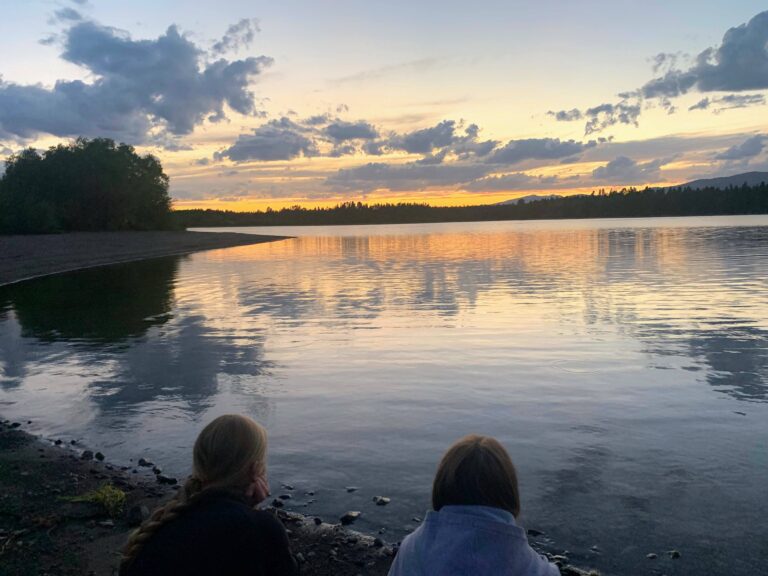by Sophie Richards
One February morning I wrote in my journal, “I just saw the sun come up over the mountains by watching the light gradually fill my kitchen…and that’s how I know that God watches over the earth and me.” I have Annie Dillard to thank, at least in part, for my eyes being open to that sunrise. Anyone who has read Pilgrim at Tinker Creek knows of Dillard’s gift for noticing and describing the wonders and perplexities of the natural world.
In the book, she illustrates in vivid, poetic detail some of the creatures and features of the land around her home in rural Virginia. She puts into words the feeling of awe inspired by a huge mass of starlings swooping through the sky at twilight. She details the less common but nonetheless breathtaking sight of watching a giant water bug swiftly devour a frog. She contemplates the wren’s trilling, the ink-like shadows on the face of a mountain, and the red blood cells coursing through a goldfish. As I read this book, I recognized that Dillard was not simply cataloguing what she saw; she was inviting me to look around and see these wonders for myself. “What you see is what you get,” she writes with pithy simplicity (Dillard 1998, 17). Like Elisha praying that his servant might have eyes to see God’s hand, Dillard exhorts us to open our eyes and see the earth.
One strategy that will allow us to open our eyes and see both heavenly help and the wonder of the earth, two compatible and complementary objects of our seeking, is mindfulness. The American Psychological Association defines mindfulness as “an awareness of one’s internal states and surroundings.” Often connected with mindfulness are the principles of meditation and stillness. Leaders of the Church of Jesus Christ of Latter-day Saints have been promoting these principles for years, and with particular emphasis recently. They have encouraged us to slow down, commune with God, and unplug from the busyness of the world (see, for example, McKay, Bednar, Nelson). The scriptures teach us to “be still” (see Psalm 46:10, D&C 101:16) and to listen for the “still, small voice” of the Holy Ghost (see, for example, 1 Kings 19:12, 1 Nephi 17:45, D&C 85:6).

President Russell Ballard, in a 2015 devotional to youth and young adults, said, “I have wondered if those who lived in the past had more opportunity than we do now to see, feel, and experience the presence of the Spirit in their lives. Seemingly, as our world gets brighter, louder, and busier, we have a greater challenge feeling the Spirit in our lives.” In a similarly distracting way, this “brighter, louder, and busier” world often keeps many of us from paying attention to and enjoying the natural beauty of our planet. In both cases, it is an issue of focus rather than accessibility. We will feel God’s Spirit more and find wonder and peace in His creations if we put our mind to it.
It is unsurprising that stillness, God, and nature are connected. The scriptures record many instances of God’s children going into wild places to commune with Him (see Luke 5:16, Enos 1:3-4, etc). In my experience, this approach works now as it did then. Stepping out of the plugged-in world and into the wilderness of nature is the first step. Next, we have to really look. Annie Dillard writes that “vision . . . is a deliberate gift.” (1998, 18). Passivity must give way to active, riveted, rigorous focus (see Nelson). She writes further, “Unless I call my attention to what passes before my eyes, I simply won’t see it.” (1998, 33). And so, when we hike into the mountains or pass the honey locust tree on a neighborhood walk or open our scriptures, we must call our attention to what is in front of us. We must strive to be mindful, aware, present.
And what might we find when we start really looking and listening? The secrets of the universe (Maxwell). Personal revelation and peace (Nelson). A deeper form of worship as our heartfelt devotion and full attention become “an expression of our love for Him” (Budge). A sense of “a beauty inexhaustible in its complexity.” (Dillard 1998, 141). A recognition that we are seeing “a shred of the infinite possible combinations of an infinite variety of forms.” (Dillard 1998, 147). We will stand in awe, with gratitude to God for His creations and love. Naturally, we will feel a greater need and desire to protect the complex beauty of the earth. Our worship will be intertwined with our efforts to care for Creation.

Some mornings I wake up with eyes to see the subtle variations of light in the sky. Other mornings the glow from my phone screen pulls my attention away from the light peeking through my window. I’m working on directing my eyes to the sky rather than the screen. As Annie Dillard writes, “Beauty and grace are performed whether or not we will or sense them. The least we can do is be there.” (Dillard 1998, 10). My life has been filled with peace, joy, and inspiration as I have mindfully looked around at the abundant goodness that already surrounds me. My hope is that having truly opened my eyes to this goodness, I — and we — will take action to preserve the earthly portion of this abundance through acts of care and stewardship.
Dillard, Annie. Pilgrim at Tinker Creek. New York: HarperCollins Publishers, 1998
Sophie Richards is an omni-interested language professional currently working as a linguistic consultant and translator. She enjoys making frequent visits to bakeries and reading about art, science, and current events. Originally from McLean, Virginia, she currently lives in Provo, Utah.
